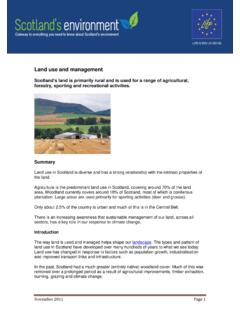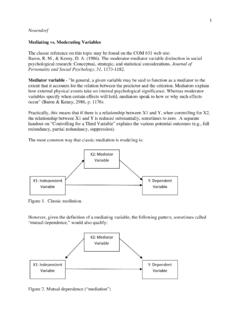Transcription of Climate - Home | Scotland's environment web
1 5th June 2014 Page 1 Climate Scotland generally has cool summers, mild winters and rain falls throughout the year. Over the last century it has become warmer, with drier summers, wetter winters and more frequent heavy rainfall. Summary Key messages Scotland has a variable Climate . We have cool summers, mild winters and rainfall spread throughout the year. Within the country, there are regional differences in Climate as well as differences between seasons. Over the last century, our Climate has become warmer, while altered precipitation patterns have led to drier summers, wetter winters and more frequent heavy rainfall. The world's Climate is changing at an unprecedented rate. Since the late 1800s, the atmosphere and ocean have warmed, amounts of snow and ice have diminished, the sea level has risen, and concentrations of greenhouse gases in the atmosphere have increased. People are causing this rapid change in Climate mainly due to greenhouse gas emissions.
2 We need to reduce our greenhouse gas emissions to prevent further Climate change. We also need to prepare for the Climate change that we cannot avoid due to our previous emissions. The Climate Change (Scotland) Act 2009 makes a commitment to cut greenhouse gas emissions in Scotland by 80% of 1990 levels by 2050. The Act sets a framework for action in Scotland to reduce emissions as well as adapt to a changing Climate . State and trend Scotland s Climate is currently in a good state for people to live in; however, it is changing rapidly. Over the last 100 years it has become warmer, while altered precipitation patterns have led to drier summers, wetter winters and more frequent heavy rainfall. Changes in our Climate over the next few decades are unavoidable because of the greenhouse gases already in the atmosphere. When viewed over long-term averages, we expect the UK to experience more milder wetter winters and more hotter drier summers in the future.
3 These changes in Climate and their effect on our weather will have major implications for our way of life. 5th June 2014 Page 2 Overview Weather is the temperature, precipitation (rain, hail, sleet and snow) and wind we experience. It is short term and changes from hour to hour, and it can be localised in small areas. Climate is the average weather taken over a long period of time typically 30 years. It is what we expect rather than what we actually get. So, while the weather brings different temperatures across the country every day, the long-term average maximum air temperature for Scotland between 1981 and 2010 was C, while the average minimum air temperature was C. Scotland s Climate Scotland has a temperate maritime Climate (temperate because it has moderate temperatures and maritime because of the influence of the sea). We generally have cool summers, mild winters and rainfall spread throughout the year. However, even within a small country there are regional differences as well as differences between seasons.
4 These are caused by a range of factors, including latitude, distance from the sea, prevailing winds, ocean currents and altitude. A changing Climate We have been collecting weather data in Scotland since the 19th century; the first network was set up in 1855. Data show that Scotland s Climate has changed rapidly during this time it has got warmer (Figure 1), while altered precipitation patterns have led to drier summers, wetter winters and more frequent heavy rain. 5th June 2014 Page 3 Figure 1: Average annual surface temperature in Scotland compared to the 1961 1990 average Source: Scottish Government: High level summary of statistics trends - annual mean temperature Global Climate change On a global scale, it has become more and more apparent that the world's Climate is changing faster than ever before. The Intergovernmental Panel on Climate Change (IPCC) report Climate Change 2013: The Physical Science Basis confirms that since the late 19th century the atmosphere and ocean have warmed, amounts of snow and ice have diminished, the sea level has risen, and concentrations of greenhouse gases in the atmosphere have increased.
5 Each of the last three decades has been successively warmer at the Earth s surface than any preceding decade since 1850 (Figure 2). Scientific evidence suggests that in the northern hemisphere, there is a likelihood of between 66 and 100% that 1983-2012 was the warmest 30-year period in the last 1,400 years. 5th June 2014 Page 4 Figure 2: The difference between the average decadal temperature in Scotland and the average 1961-1990 temperature. British Crown Copyright 2014 Source: Met Office On a global scale, 13 of the 14 warmest years since modern records began in 1850 occurred in the 21st century. Causes of Climate change The main cause of Climate change is increasing greenhouse gas concentrations in the atmosphere. The Earth receives heat from the sun. About half of this energy is absorbed by the Earth s surface, some is absorbed by the atmosphere and some is reflected back into space. As the surface of the planet heats up, some of the heat is emitted back into the atmosphere and absorbed by greenhouse gases, which trap the heat and keep the Earth warm.
6 This is a natural process and known as the greenhouse effect (Figure 3). However, if concentrations of greenhouse gases in the atmosphere increase, more heat is trapped and the Earth becomes even warmer. This is known as the enhanced greenhouse effect . 5th June 2014 Page 5 Figure 3: The greenhouse effect The main greenhouse gases are: water vapour (H2O); carbon dioxide (CO2); nitrous oxide (N2O); methane (CH4) and ozone (O3). These are formed as a result of natural and human activities. There are also a number of entirely human-made greenhouse gases in the atmosphere, such as sulphur hexafluoride (SF6), hydrofluorocarbons (HFCs) and perfluorocarbons (PFCs). These gases accumulate in the atmosphere. Significant increases in concentrations of CO2, CH4 and N2O occurred in the industrial era (Figure 4). All of these increases have been caused by human activities. The global increases in CO2 concentration are due primarily to using fossil fuels and changes in land use, while those of CH4 and N2O are mainly due to agriculture.
7 Figure 4: Atmospheric concentrations of important greenhouse gases over the last 2,000 years. Increases since about 1750 are due to human activities in the industrial era Source: IPCC The IPCC reports that scientific evidence now shows with at least 95% certainty that human activity is the main cause of global warming since the mid-20th century. While the recent rapid change in Climate can be attributed to human activities, the Climate has also changed throughout geological time, well before people were around. This is known as natural Climate variability and is due to a number of factors, including: changes in solar activity; changes in the Earth's orbit; volcanic eruptions; 5th June 2014 Page 6 aerosols; El Ni o and La Ni a. The difference between weather and Climate , what drives our Climate and how our Climate is changing is summarised on the Met Office website. Environmental state and trends State Scotland generally has cool summers, mild winters and rainfall spread throughout the year.
8 However, there are regional differences as well as differences between seasons. The south is generally warmer than the north in summer, mainly due to the influence of latitude. The west is generally milder, cloudier and wetter than the east due to the prevailing winds from the south-west and the influence of the North Atlantic Drift. The east is also sheltered by the mountain ranges in the west, which create a rain-shadow effect . The west also has a lower range of temperatures than the east because of the moderating influence of the Atlantic Ocean. The north and west Highlands usually have lower temperatures throughout the year than the low-lying areas in the south and east because of the influence of altitude. The west has more rain in winter, when Atlantic depressions are more frequent. Scotland can be separated into three climatic zones north, east and west. Regional Climate summaries for northern, eastern and western Scotland are available on the Met Office website.
9 More detail on regional Climate statistics can also be found on the Met Office website. Trends Scotland's Climate Trends Handbook is published on this website. The handbook describes the changes in weather patterns experienced in Scotland over the last century. The following text summarises the recent Climate trends over the period 1961-2011 (unless stated otherwise). Temperature Across Scotland the mean annual temperature has increased by C, with the biggest seasonal change found in spring which has warmed by C on average. The mean temperature has also increased for all seasons in all regions by at least 1 C. The maximum temperature has increased for all seasons in all regions. The increases have been slightly greater than those observed in mean annual temperatures. 5th June 2014 Page 7 The minimum temperature has also increased for all seasons in all regions. The increases have been slightly less than those observed in mean annual temperature, with the length of cold spells reduced by almost eight days across Scotland (from 1961-2003).
10 However, two exceptionally cold winters (2009/2010 and 2010/2011) have occurred in recent years the winter of 2010/2011 was the second coldest since that of 1985/1986. Frost All regions have seen a decline in the number of days a year on which there is air or ground frost, with a reduction of 21 days of air frost and 29 days of ground frost for Scotland. However, in 2010 the UK experienced the coldest December for over 100 years. Although changes in the total number of air frost days are largest in winter, it is spring and autumn that have seen the largest changes as a percentage and that show a significant downward trend. Sunshine Since 1961 there has been a clear increase in sunshine hours for all regions of Scotland in the spring. There has also been an increase in sunshine hours in autumn, but summer and winter have seen little change. Rainfall Although there has been an overall increase in rainfall (27%), it varies among seasons and regions.









